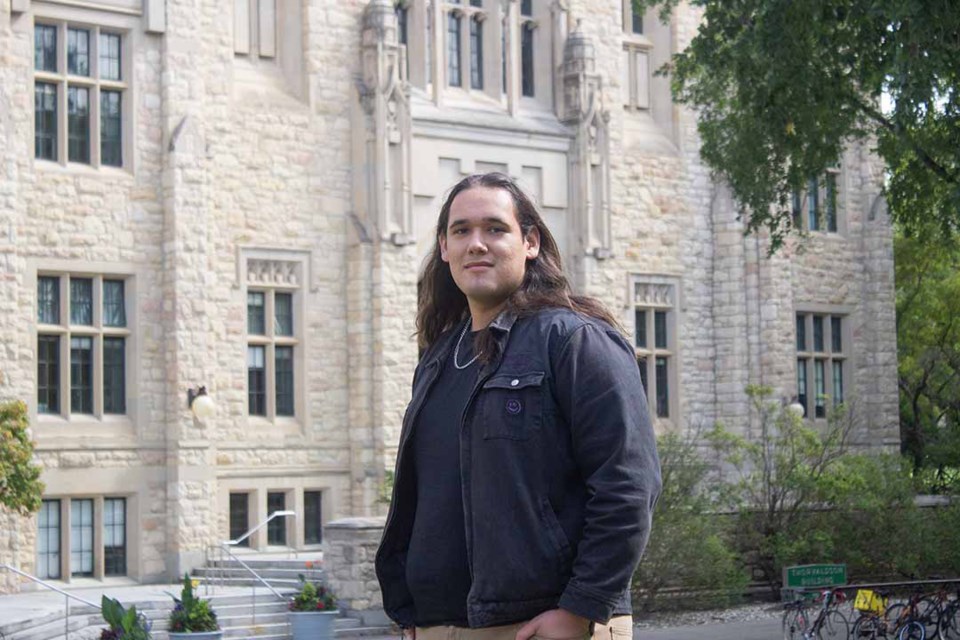SASKATOON — A video game helped inspire Indigenous student Noah Merasty to major in computer science at the University of Saskatchewan (USask).
The game Cyberpunk 2077 featured characters called “net runners” who were hackers.
“I figured it would be cool to be a hacker,” Merasty said. He added that depictions of hackers in media often portrayed the characters as having almost magical abilities to overcome impossible feats.
Merasty is from Flying Dust First Nation and grew up in Saskatoon. In high school, Merasty took computer science classes to learn the basics of the subject and gain programming skills. While he wasn’t a fan of math as a subject, Merasty joked that he found interest in a field that uses math the most.
“In high school, I found out you could be a hacker legally,” he said. “People can hire hackers all the time to protect their infrastructure (from cyber-attacks).”
Once Merasty started taking computer science courses at USask through the Medicine Wheel Learning Community, he knew he was on the right path.
Merasty plans to continue his academic journey after completing his undergraduate degree by pursuing his master’s degree and a PhD. When ISAP team lead Dr. Sandy Bonny (PhD) learned about Merasty’s plans, she connected him with computer science professor Dr. Julita Vassileva (PhD).
Though he was only a first-year undergraduate student, Vassileva encouraged Merasty to apply for Undergraduate Student Research Awards (USRA) within the Natural Sciences and Engineering Research Council of Canada (NSERC).
NSERC is one of three major research funding agencies in Canada. The agency funds researchers who are searching for scientific and technical breakthroughs in the country. The USRA program supports more than 3,000 students across Canada to further develop a research career in health, natural sciences, engineering, social sciences or humanities.
“I was a little unsure, because I was in my first year,” Merasty said. “But then I talked to my mom, and she was like, ‘You should just do it, they know you’re in your first year—they'll teach you the things you need to know.’”
"It was kind of freeing, realizing that they know that I don’t know everything. I know how to code, basic programming—basic understanding of computer science,” he said. “That helps in a lot of ways, because I realize that if I need to know something more, they’re going to teach me. Otherwise, I have all the skills I’m going to need.”
Merasty’s cited his family as –°¿∂ ”∆µ a source of inspiration and support as he decided to pursue computer science.
Merasty is the youngest of five siblings, all of whom are pursuing post-secondary education. Merasty’s mother is currently pursuing a PhD in public policy, while his father at one point had pursued law school before deciding on another path.
His kôhkom, or grandmother, played an instrumental role in the creation of the Saskatchewan Indian Federated College (now the First Nations University of Canada). His mosom, or grandfather, was a civil engineer.
"Education has always been a huge part of my family, so I’m just trying to honour that by doing well,” he said.
Merasty’s research over the summer resulted in a poster, titled “A Comprehensive Study on the Attacks and Defenses in Federated Learning,” which will be displayed in a fall research showcase on campus.
He worked with graduate student Mehdi Khalaj, who helped guide Merasty through his research project, and is listed as an author on the project.
His research project will also be published as a paper—a major step in his fledgling research career at 18 years old.
Merasty noted he is excited to present his summer research and looking forward to his second year at USask. He shared a piece of advice with students if they’re considering research opportunities.
“I guess if you’re a first-year student, like I was, just do it if you have the opportunity to do it,” he said. “(Research) is going to help you in so many ways.”
“The supervisors know fully well you’re not going to know everything, right? You’re not trying to prove that you’re an expert, you’re trying to become an expert. That’s my mentality.”
— Submitted by USask Media Relations




